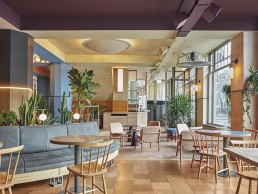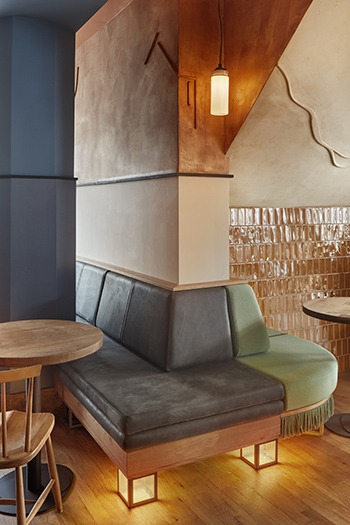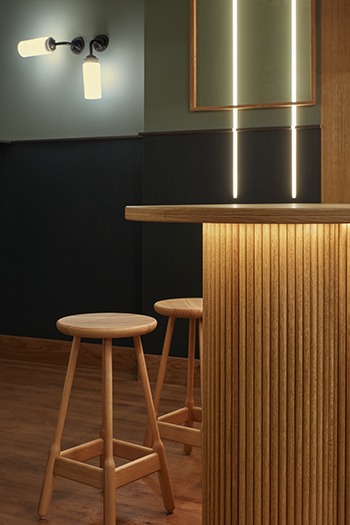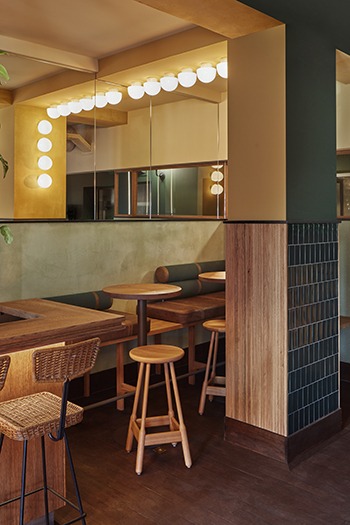
Karavaan, Netherlands
Studio Modijefsky harnessed the concept of migration and the journey of the caravan, to create a unique destination in the heart of Amsterdam.
In the brightest corner of Amsterdam’s historic Kwakersplein Square, Studio Modijefsky has created Karavaan – an exciting new destination for Amsterdammers. Initially a polder area outside of the old city limits, Kwakersplein became part of the Bellamy neighbourhood after being dammed in the 19th century. Ever since then, people have been migrating towards this spot, just like a caravan.
Studio Modijefsky translated this migration into the concept designs for Karavaan – a venue that combines an all-day hangout, bar, café, cocktail bar, breakfast club and restaurant. “Karavaan is a place where you travel to and unexpectedly have a long stay,” Studio Modikefsky’s Esther Stam tells darc. “It is a vacation in your own town.”
The interior is subtly divided into different landscapes: meadow, swamp, forest, mountain and desert, with each zone characterised by its own colour scheme, materials and design specifics, all unified by a trail that crosses the entire space. As you enter through the main vestibule, a bespoke circular ceiling light defines the lounge area underneath. From here, the space unfolds into different directions indicated by changes in colours, interior finishes and light objects. Looking to the right, a small bar with a toned-down fresh pastel palette is connected to a second entrance, located at the corner of the building.
Walking across the herringbone wooden floor, towards the natural oak bar, the white ceramics, staggered yellow tiles and the light wool carpet ceiling, creates the feeling of being in the tall grass of a meadow. This bar changes its function throughout the day, from a morning coffee spot to a window seat for an evening drink. This transition is suggested by a structure of mirrored light panels hanging above the bar, designed in-house by Studio Modijefsky, that can be flipped, changing from ‘Karavaan Caffeine’ to ‘Cocktail Karavaan’.
As the meadow bar wraps around the corner, playful bespoke seating leads customers to another level, into one of the dining areas. Here, the colours are more dramatic, conveying a mysterious atmosphere; the glossy ceiling, deep blue column and stucco walls recall the reflections of the water and roughness of the deltas of a swamp. A similar vibe reappears on the opposite side of the venue, overlooking the square, where a dark purple ceiling and a tailor-made curved bench create a cosy corner with the adjacent column, separating the bar from the dining area.
Traversing the different landscapes, the central bar runs along the back of the space, where lines of light, jute fabric and rough plaster intertwine, leading guests towards it. Dark cork panels join with wooden slats, while a reflective zinc bar top intermingles with the dense wood. Glass racks are reflected on the mirror tiles of the back bar, which are crossed by a wavy line of light. The adjacent portion of the ceiling, delineated by four beams, defines the centre of the space through a multitude of Trainspotters’ Mushroom lights, springing up from a mirror.
Stepping down from the bar, the floor changes its pattern from herringbone to diagonal. Far from any natural source of light, the use of dark colours and rigid lines make this zone feel like a dim forest. A high bench with a green cylindrical backrest, detailed with leather accents, overlooks the space. Vertical beams of light come through the walls, resembling the rays of sun peeking through dense tree trunks, resulting in an enchanted atmosphere. Opposite these lines of light, light grows out of a planter, with Trainspotters’ white globes adding a playful element between the plants. The feeling of the forest spreads towards the adjacent room and meets a desert, creating an eccentric mix of bright colours, brown wood veneer and green tiles.
Elsewhere, beams of light on one side, and an arc of light on the other, embrace a small wooden bar and playful high seating, creating an intimate corner. Just a few steps from the small bar, warm colours and softer lines create a more gentle vibe – the tiled floor is covered by a soft rug, while the wooden slats of the walls are softened by a velvet golden curtain. Red velvet lounge chairs complete the relaxing ambience.
While the interior is broken up into multiple zones, each offering their own distinct ambience, Stam says that the introduction of different kinds of lighting, both in terms of decorative and architectural pieces, is something that Studio Modjefsky hoped would differentiate the zones.
“Specific types of lights have distinct functions: a light line on the wall creates a landscape and guides people towards a specific point; a family of ceiling lights suggests there is a gathering point underneath. The light doesn’t only contribute in creating a nice atmosphere, but it guides people throughout the space.”
Further to this, the interior designers used light – either bespoke pieces designed by the studio itself, or pendants and wall lights from Trainspotters – to create stand-out focal points throughout. “The bar itself needed to stand out. Above the coffee bar at the entrance we thought of the mirror panels with light integrated in one of the sides to form a composition of lamellas, which can be seen from the street,” Stam explains.
“Deeper down in the dining area, we designed a light string that runs from the window in the façade, all the way along the wall, and ends in the main bar. Here, a light box with textured glass, integrated lights in the back wall and a line of light underneath the counter, capture the attention and invite the client to approach the bar.
“The lounge space has its own light accents, with a row of light spheres placed on the ceiling and column, facing a mirror that is reflecting the lights once more. Also, smaller light accents, such as little cubes underneath a long custom bench, form playful ornaments, giving the place its own character.”
By giving each zone its own unique “light language”, Stam feels that Studio Modijefsky was able to bring a different atmosphere, and as such a broader diversity, to the space. “We don’t use light as a strictly practical element to illuminate the environment, but as a key element to create a warm atmosphere,” she says. “A line of light under the counter, for example, isn’t simply used to indicate where the bar is, but it complements the colour of the material underneath, emphasising some shades that would otherwise be invisible – it gives body to the space.”
Throughout its portfolio of work, Studio Modijefsky looks to tell a story through its designs, by analysing the history of the building and its surroundings, combining this with how the space is today, and the branding of the client. This is what forms the basis for the design concept, and the design language that is specific to each particular project. Here, the interior designers harnessed the concept of migration, of the journey of the caravan, to create a unique destination.
“It’s all part of a complete story,” Stam says. “Like a caravan using landmarks to know the way, we created accents on walls that guide people through the space; sometimes light lines that lead the eye through the space, sometimes light ornaments hanging in a certain direction, and sometimes a special light fixture enriching a specific zone… it gives each space its own character, and transforms Karavaan into a unique location.”






